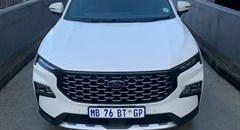Ford is conducting the industry's first autonomous vehicle tests in snow-covered environments - a major step in the company's plan to bring fully autonomous vehicles to millions of customers worldwide.
Autonomous vehicles have previously only been tested in dry and mostly sunny climates. "It's one thing for a car to drive itself in perfect weather," said Jim McBride, Ford technical leader for autonomous vehicles. "It's quite another to do so when the car's sensors can't see the road because it's covered in snow. Weather isn't perfect, and that's why we're testing autonomous vehicles in wintry conditions.
Ford's winter weather testing takes place in Michigan, including at Mcity - a 32-acre, full-scale simulated real-world urban environment at the University of Michigan.
The need for snow autonomy
Fully autonomous driving can't rely on GPS, which is accurate only to several yards - not enough to localise or identify the position of the vehicle. And it's key that an autonomous vehicle knows its precise location, not just within a city or on a road, but in its actual driving lane - a variation of a few centimetres makes a big difference.
LiDAR is much more accurate than GPS - identifying the Fusion Hybrid's lane location right down to the centimetre. LiDAR emits short pulses of laser light to precisely allow the vehicle to create a real-time, high-definition 3D image of what's around it. In ideal weather, LiDAR is an efficient means of gathering important information and metadata - underlying information about the data itself - from the surrounding environment, sensing nearby objects and using cues to determine the best driving path.
But on snow-covered roads or in high-density traffic, LiDAR and other sensors such as cameras can't see the road. This is also the case when the sensor lens is covered by snow, grime or debris. Thus, Ford and University of Michigan technologists began collaborating toward a solution that would allow an autonomous vehicle to see on a snow-covered road.
How snow autonomy works
To navigate snowy roads, Ford autonomous vehicles are equipped with high-resolution 3D maps - complete with information about the road and what's above it, including road markings, signs, geography, landmarks and topography.
"The maps we created with Ford contain useful information about the 3D environment around the car, allowing the vehicle to localise even with a blanket of snow covering the ground," said Ryan Eustice, associate professor at University of Michigan college of engineering.
An autonomous vehicle creates the maps while driving the test environment in favourable weather, with technologies automatically annotating features like traffic signs, trees and buildings. When the vehicle can't see the ground, it detects above-ground landmarks to pinpoint itself on the map, and then subsequently uses the map to drive successfully in inclement conditions.
"The vehicle's normal safety systems, like electronic stability control and traction control, which often are used on slippery winter roads, work in unison with the autonomous driving software," said McBride. "We eventually want our autonomous vehicles to detect deteriorating conditions, decide whether it's safe to keep driving, and if so, for how long."

















































